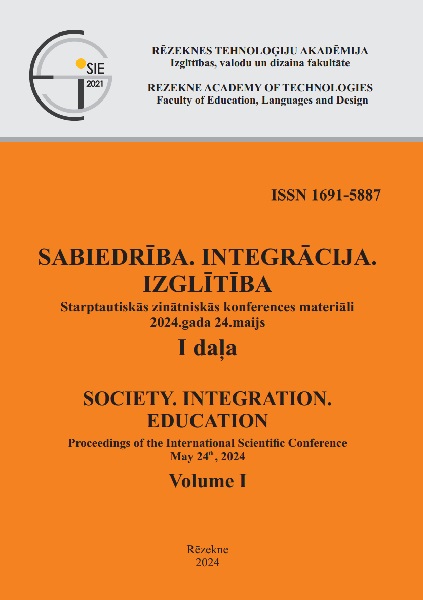“SCHOOLS FOR LADIES AND GENTLEMEN” AS A SPECIFIC FORM OF NON-FORMAL EDUCATIONAL INSTITUTIONS IN FAR EAST COUNTRIES (China, Japan, South Korea and Singapore)
DOI:
https://doi.org/10.17770/sie2024vol1.7812Keywords:
China, Japan, non-formal education, Singapore, South KoreaAbstract
”Schools for Ladies and Gentlemen" is a term commonly used to determine a non-formal educational institution in some of Far East countries where the students are taught mainly abroad ethics and aesthetics. Such educational institutions can be considered a vestige of the foreign countries` presence on the territory of the countries under consideration in the 19th-20th century, since it was the social activity of some European countries and US that largely determined the shape and value orientation of the education system in China, Japan, South Korea and Singapore in particular. The second half of the 20th century in the countries considered is characterized by a revision of foreign educational trends, which led to the departure of the abroad educational experience from the mass formal education. However, the social prestige of “foreign education” and the introduction of a child to “foreign ethical and aesthetic canons” as an indicator of financial well-being and social elitism has been preserved and has found its expression in the sphere of non-formal education in the form of clubs, circles, the services of private tutors, etc. The article examines the exact forms in which this trend is present in the educational sphere of one or another country in the Far East.
References
Bag, M.H. & Baeg, Il.U. (2016). History and features of the Korean private education market. Future Education Research, 29(2), 23–50. (Korean language)
Bagnall, R. (2017). Nonformal education and civil society in Japan. International Journal of Lifelong Education, 36(4), 503-504. DOI: 10.1080/02601370.2016.1276328
Chuong, D.V. (2018). Education in Southeast Asia from the second half of the 19th century to the early 20th century. US-China Education Review, 8, 4, 141-146. DOI: 10.17265/2161-6248/2018.04.002
Engriyani, E. & Madhakomala, R. (2023). The Implementation of Non-Formal Education and Training Programs to Encourage the National Economy Concerning the Unemployment Rate in Southeast Asia. International Journal of Social Science and Human Research. DOI:10.47191/ijsshr/v6-i11-52.
Good Job Korean. (2023). Hagwon: The Unique Private Education Institution in Korea. Retrieved from https://www.goodjobkorean.com/blog/hagwon-the-unique-private-education-institution-in-korea
Harper, T. (2009). The Tools of Transition: Education and Development in Modern Southeast Asian History. University of Cambridge. Retrieved from https://hummedia.manchester.ac.uk/institutes/gdi/publications/workingpapers/bwpi/bwpi-wp-9209.pdf
Kim, Y.C. (2016). Shadow Education and the Curriculum and Culture of Schooling in South Korea. Chinju National University of Education.
Noah's Boat. (2022). China's Top Ten Private Education Brands. Retrieved from https://zhuanlan.zhihu.com/p/383905762?utm_id=0 (Chinese language)
Official site of Matsue-city kouminkan (2021). We held a parent-child golf experience at a group to raise children! Retrieved from https://matsue-city-kouminkan.jp/tuda/katsudou/doc/2023072300012/ (Japanese language)
Official site of Ministry of Education of Singapore. (2024). Overview of Singapore`s educational system. Retrieved from https://www.moe.gov.sg/-/media/files/about-us/overview_of_singapore_education_system.pdf
Official site of Sunnyside International School. (2024). What is IB World School? Retrieved from https://www.sunnyside-international.jp/learning/ib/ (Japanese language)
Shanghai Association of non-government education. (2021). Market status and report analysis of the private education industry in 2021. Retrieved from http://www.shmbjy.org/item-detail.aspx?NewsID=14179 (Chinese language)
Scibiorska-Kowalczyk, I. & Cichon, J. (2021). The Significance of Cultural Policy—Case Study of South Korea. Sustainability. 13(24), 13-80. DOI: 10.3390/su132413805
Shi, L. (2019). Functions of non-formal education in modern China. Modern education and upbringing. 7. 34-38. (Chinese language)
Smith, M.K. (2001). Informal and non-formal education, colonialism and development, The encyclopedia of pedagogy and informal education. Retrieved from http://infed.org/biblio/colonialism.htm
Spires, R. (2017). Hong Kong’s Post-Colonial Education Reform: Liberal studies as a lens. International Journal of Education Reform, 26(2), 156-175. Retrieved from https://core.ac.uk/download/pdf/232790366.pdf
Statista. (2023). Average monthly expenditure on private education per student in South Korea in 2022, by household income. Retrieved from: https://www.statista.com/statistics/642524/south-korea-spending-for-private-education-by-household-income/
Sun, W. & Xue, L.R. (2021). English Education Reform in Asian Countries. EDUCATION. DOI: 10.1093/acrefore/9780190264093.013.838
Yiteng Education. (2020). Analysis of private education in Singapore, recommendations for two private primary and secondary schools. Retrieved from https://baijiahao.baidu.com/s?id=1655056168323872603&wfr=spider&for=pc (Chinese language)






